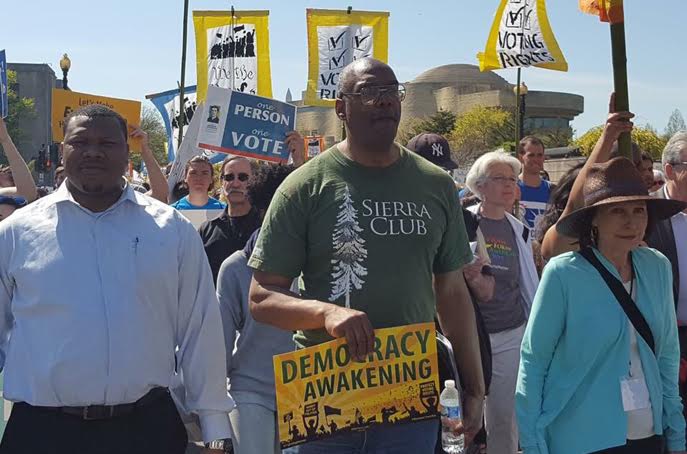Aaron Mair, an epidemiologist for the New York State Department of Health and recipient of the Spirit of John Brown Freedom Award, ended his term as Sierra Club president on May 20. The Club’s first African-American President, he spoke with The Planet about his decades-long career in the environmental justice movement, the Sierra Club’s history, and his views on environmental and civil rights activism.
Mair sees the causes of environmental protection and racial equality as intertwined, and he’s passionate about unifying the two. “If one is going to be an environmentalist in the 21st century, one has to be a human rights activist,” he declared. “People say, ‘well, that’s social justice, that has nothing to do with environmentalism.’ That’s bullcrap!”
He’s referring to environmental injustice, examples of which abound across the United States, such as lead poisoning in Flint, Michigan and the Dakota Access Pipeline on tribal land in North Dakota. As an epidemiologist, Mair is aware that health conditions are connected to environmental risk and exposure. “The human body is like a piece of litmus paper,” he noted. Poor communities are often left with the land polluted by industrial waste, and when people in these communities display signs of illness related to pollutants, it’s a reflection of inequality.
This overexposure to pollutants is something with which he has firsthand experience. When the state of New York built a trash incinerator in the predominantly black neighborhood of Arbor Hill in Albany, New York, in 1994, exposing the residents to high levels of dioxin and lead, Mair, seeking support from other activists, brought a lawsuit against the state.
“That is the thing that called upon all my life experiences,” said Mair. “That was the intergenerational experience from civil rights, human rights, and [I was] linking that with the environmental movement.” Mair reached out to the Sierra Club’s Atlantic Chapter for backing, but was initially turned down. “It was common at that time for minority communities not to receive the support of the Sierra Club,” he wrote in a May 9 blog post. After a 10-year struggle and an incident where the plant spewed a black soot-like substance that blackened snow and covered lawns and porches, the state closed the plant and awarded a $1.6 million settlement to Arbor Hill.
In the coming years, Mair would take up other environmental justice causes, like removing toxic PCB pollutants from the Upper Hudson River where black and Latino communities actively fish for food, and helping to fix the aging, leaky Indian Point nuclear power plant, building a close relationship with the Sierra Club over time.
The Sierra Club’s agenda hasn’t always been as inclusive to people of all socioeconomic statuses and races as it is now. In fact, its founding figures, revered conservationists like John Muir and Joseph LeConte, had a eugenicist, social Darwinist worldview that influenced the Sierra Club until it manifested in the horror of 1940’s Nazi Germany. “Their vision of environmentalism at that time had a very deep racist component,” said Mair. “These people were very ardent eugenicists and racists. And it was very much part of their unified theory of naturalism.”
It wasn’t until the second half of the 20th century, when a new strain of environmentalism took hold, that this ugly legacy could begin to be undone. Mair was and continues to be a part of this shift. During his tenure as president, he took several measures to rectify the old system of beliefs and make the Sierra Club more inclusive, including adopting a diversity statement, creating a Department of Equity, Inclusion and Justice, and establishing the Club’s first Spanish-speaking chapter in Puerto Rico.
On May 8, Mair received the Spirit of John Brown Freedom Award for his achievements in environmental justice. It was an occasion for him to consider the legacy of the Sierra Club and his role in it as its first African-American president. At the ceremony, Mair spoke of “healing history,” a phrase meant to evoke the process that Mair undertakes in acknowledging and rectifying the discriminatory past of the Sierra Club.
Mair is emphatic that environmental and civil rights are inextricable, and has put that belief into action. He has remained active in grassroots campaigns since the end of his term, and is eager to help work with other advocacy groups to help build a bridge between environmental activism and civil rights in pursuit of a more inclusive future for all.
